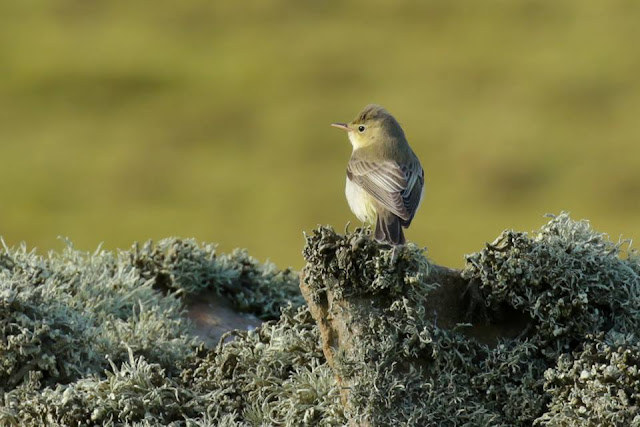September
on Fair Isle summary
Green
Year list now on 293 having had 15 new birds whilst being on the Fair
Isle, 14 of them during September. I had a booted warbler on arrival
at the end of August, so let's start with that wonderful bird.
BOOTED WARBLER Iduna caligata
30th August 2016
Seen in the small reedbed that
makes up Meadow Burn, a small, very pale warbler that showed well on
the wires that surround the area. Booted warbler comes from Central
Russia and Asia.
There were a lot of migrants
around on my arrival day; 63 willow warblers, 176 wheatear, 106 white
wagtails as well as a couple of barred warblers,and singles of marsh
warbler and common rosefinch. Welcome to Fair Isle. A.D.I.P. ….. a
day in Paradise.
My second Rose-coloured starling,
Pastor roseus was found by Cath Mendez at the Bird
Observatory, coming down to feed on apples put out by Lee Gregory for
just that possibility. A juvenile bird, pale and obvious, rosy is a
vagrant from Central Europe.
Into
September. The target was for 15 year ticks and a spreadsheet was
prepared months ago detailing the year tick bird species seen on Fair
Isle during this month for the last 11 years. A percentage
probability is mentioned after each of the following year ticks seen
in brackets.
WOOD WARBLER Phylloscopus
sibilatrix 4th September 2016
One would have expected me to
have added this bird to the year list whilst on the UK mainland but
no, I wasn't near any of the declining breeding birds' areas during
those crucial times before mid-June when they go quiet. One turning
up on Fair Isle was a bonus not too unexpected. Sitting on a barbed
wire fence with the occasional jump down onto the grass to catch an
insect, a beautiful, bright warbler with white underparts, yellow
throat and green back. (45.5% chance of occurrence in September)
ICTERINE WARBLER Hippolais
icterina
David Parnaby, the Fair Isle
Bird Observatory warden, had found a greenish warbler, Phylloscopus
trochiloides, in Tyneside Geo. I saw him walking on the other side of
the long, tall dry stone wall called Hill Dyke and thanked him for
the text message telling me of that bird. As I turned away a large
Hippo' warbler landed on the barbed wire fence about thirty yards
away. I emmediately shouted to David, “Icky.”
Another hoped to see warbler
went onto the list; an obvious Hippolais, large and stronger than
similar Phyloscs. After walking to the greenish warbler, I carried on
exploring the geos, high cliffed areas of coast that provide shelter
and food for many fresh in migrant birds. At Grey Geo, one of my
favourites with a fast eroding cliff line and colourful rock and mud
sections, another icterine warbler was foraging in short grass.
Classed as a rare vagrant to the UK from the continent. (45.5% chance
of occurrence in September)
Good numbers of migrants today, I
found not only the couple of icterines but also a sunbathing barred
warbler on the cliff at Copper Geo. 4 swifts were swirling just west
of Ward Hill and the greenish warbler was my second of the year.
ORTOLAN BUNTING Emberiza
hortulana 8th September 2016
Not an easy one to find, the
bird hid in thick grass in the marshy area just above the Gully trap
area. Eye ring and moustachial easy to see once it allowed good
views. Another vagrant from Europe. (45.5% chance of occurrence in
September)
LANCEOLATED WARBLER Locustella
lanceolata 13th September 2016
Great to see one in the field,
the bird was at first seen sitting in the open on short grass where
it stayed for a few minutes before diving into some longer grass in a
nearby ditch. Even in there it could be seen occasionally crawling
between the grass blades. The very rare warbler eventually flew to an
area of thicker grass but just sat in between grass tussocks in full
view! A small, streaky warbler; they always look to me as though they
have been squeezed from behind to give a front heavy appearance. A
true Sibe goes onto the year list, another I saw in the marshy area
of Kirki Mire later in the month. That bird was found when everyone
was searching for a great snipe! (54.5% chance of occurrence in
September)
CITRINE WAGTAIL Motacilla
citreola
A citrine wagtail had everyone
searching around the island but couldn't be pinned down to one area.
In the evening though a different bird was found by Cairan Hatsall,
one of the two assistant wardens at Da Water. A good day for Cairan,
this bird was added to the lanceolated Cairan had found earlier. The
lancy was the first one that Cairan had found.
The citrine, not a showy bird,
kept amongst the tall grass tussocks of Da Water, only showing itself
briefly on the mud. Vagrant from Asia, obvious wing bars with pale
around the cheek. (72.7% chance of occurrence in September)
SHORT-TOED LARK Calendrella
brachydactyla 14th September 2016
Lee Gregory found this bird and
despite it flying some way off when I arrived, I found it an hour or
so later by Setter, the croft of my late, dear friend, Gordon Barnes.
It flew with a skylark back to the original place where Lee had found
it and is still there today; 16 days, a long-staying and welcome
scarce migrant. Smaller, greyer and paler than skylarks, an obvious
bird with white underparts and streaky uppers. A vagrant from
Southern Europe. (36.4% chance of occurrence in September)
COMMON ROSEFINCH Erythrina
erythrina
Seen
at last in Neil Thompson's garden, Lower Stoneybrek, a finch with
pale wingbars noted deep down amongst some roses. I have since seen
two more rosefinches; one at the Bird Observatory perched high in the
garden and another one I found perched on some wooden pallets near to
the Fair Isle School. A scarce but regular vagrant from NE Europe.
(100% chance of occurrence in September)
As well as the above, a lot of
Lapland buntings were on the island today with 74 recorded.
YELLOW-BROWED WARBLER
Phylloscopus inornatus 15th September
2016
It would be a very strange year
if one wasn't to see a yellow-browed warbler on Fair Isle in
September. Gone are those days of the 1980s when one scratched around
St Mary's on The Isles of Scilly looking for one or two. Here one has
dozens and the first one for the year list was found by Lee Gregory
in the Gully. A smashing tiny warbler with wingbars and eyestripes.
More of them seem to be coming to Britain from their Siberian
breeding area and one can only hope that they are finding a way to
their wintering grounds. (100% chance of occurrence in September)
Since that vanguard bird I have
seen 48 more!
BLUETHROAT Luscinia svecica
17th September 2016
Nick Riddiford, an ex- warden
of Fair Isle Bird Observatory, thought that he had seen one at
Shirva. Indeed he had for I found it there a short while later. A
rare migrant from Europe I have since seen another that was at first
running down the road in front of me as I cycled along. (90.9% chance
of occurrence in September)
GREAT SNIPE Gallinago media
18th September 2016
Now was this one a hard one to
find!? Lee Gregory, who else? Found this in Da Water and after seeing
it fly three times eventually thought he had it at a spot where
everyone could get onto it. Birders assembled, a walk towards the
bird's location gave no views and a continued search of the area did
likewise. All went to lunch leaving me to search the marshes for over
two hours, in two metre lines from one end of each marsh to the
other. Only when I reached the end of a tatty (potato) crop did the
great snipe suddenly emerge and how. Calling roughly it flew off over
towards Kennaby where I subtly called to two birders. Did I heck! I
screamed “THE snipe!” With larger size and darker belly noted as
well as the call, great snipe not only goes onto the Year list but
also my life list.
This bird has given everyone
trouble since it's original finding. The whole process of found by
one, searched for by many but not seen was repeated over a week later
when Deryk Shaw, another ex-warden of the Observatory found it in the
field south of where I had found it previously. It may still be out
there. (9.1% chance of occurrence in September)
RED-THROATED PIPIT Anthus
cervinus
Lee Gregory looked a bit vacant
as we talked about the great snipe and where it might have
disappeared to. He was thinking about a strange pipit he had just
seen by the American Tommy Hyndeman's Guest house, Da Haa. Luckily
Lee realised that it was a red-throated pipit and so another great
year tick went down onto paper.
A grey looking pipit with
obvious braces, the first time I have seen one whilst Biking Birding.
Rare vagrant from Scandinavia. (27.3% chance of occurrence in
September)
LITTLE BUNTING Emberiza
pusilla 20th September 2016
In an oat crop this smashing
little bird came out to sit as many birds do on a wire fence. This
bird had a louse by it's right eye and so could be told from the next
one seen at nearby Field a few days later. (81.8% chance of
occurrence in September)
I have now seen three little
buntings; the last one a very t bird near to the Bird Observatory.
RED-BREASTED FLYCATCHER Ficedula
parva 21st September 2016
It never seems right to tick a
bird in the hand, the first red-breasted flycatcher for the year was
caught in the Heligoland trap at the Gully.
Much better was watching one
fly catching on the rocks far below on the beach at Hjukni Geo. This
bird's white sides to it's tail made it easy to see as it flew from
rock to rock in search of flies. An Eastern European vagrant. (63.6%
chance of occurrence in September)
A week goes by then . . .
PADDYFIELD WARBLER Acrocephalus
agricola 28th September 2016
Over breakfast a birder, Andrew
sitting opposite asked for a prediction for the day.”Paddyfield
would be nice,” I said.
Paddyfield warbler in Walli
Burn, another LIFER for me. A cracking small and very pale acro', it
flew around birders like a small moth, fluttering between iris beds.
So a month on Fair Isle, maybe
another month to enjoy as well. What will October bring? Barnacle
geese and olive-backed pipits are 100% birds but then again, with an
average of 9 year ticks over the last ten years there will be some
surprises. Male Siberian rubythroat?
All photographs by Lee Gregory.


























































